Pick your paintable piece and gather supplies.
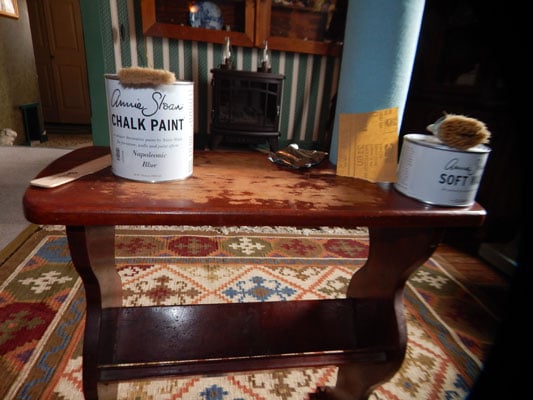
In the photo above, a vintage bookshelf/hall table that has seen better days has been selected for painting. Yes, you could choose to strip the finish and restain the wood, but that’s much more hassle than using chalk paint.
Because the natural wood that’s left has a lovely reddish color, the paint color chosen is a darker blue (when distressed later, the red will come through in places, making a nice contrast). The paint used here is Annie Sloan Napoleonic Blue chalk paint.
Annie Sloan chalk paint is sold in pints and quarts and is the original and still most popular chalk paint on the market. You can purchase chalk paint at some craft and hobby stores, online, or at your local vintage/antique/repurpose shop. You also can make your own chalk paint with a few simple ingredients.
Also seen in the photo above is a can of wax and a wax brush (for use in a later step), some sandpaper (for use in a later step), a simple chip brush (no fancy brushes needed for the paint), some shop towels (any lint-free cloth or towel works), and a piece of aluminum foil for wrapping your wet paint brush (if you need to take a break and don’t want your brush to dry out).
Clean the furniture.
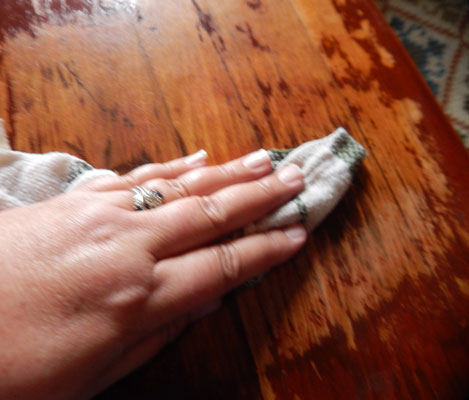
You don’t need to strip anything off your furniture, which includes old paint or old finishes, but you do need to make sure that it’s clean and dry. Simple soapy water is the best option. Don’t use furniture wax to clean it! The wax component of most furniture polishes does not mix well with chalk paint.
If you’re a sloppy painter, you might place a drop cloth or old sheet below your item. If you’re neat, don’t worry about it. If you do get chalk paint on the carpet or floor, you can remove it easily with dish soap or laundry detergent, water, and a little elbow grease.
Use the chip brush to paint your furniture.
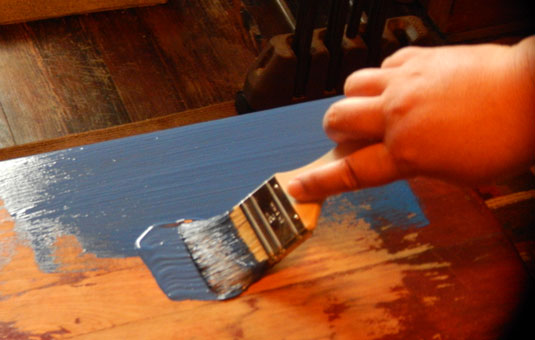
Here’s the real beauty of using chalk paint. You don’t have to be careful to get all your brush strokes going in the same direction; you don’t have to make sure that coverage is even; you don’t even have to paint every nook and cranny if you don’t want to.
For this particular piece, two coats are required on the table top, because the existing finish has already disappeared. The unfinished wood will take more paint to cover.
Lightly sand to create the perfect distressed look.
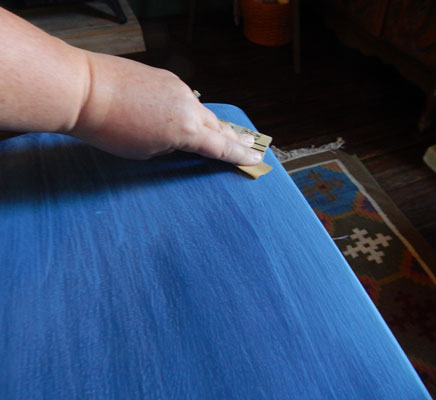
Make sure you are using a fine-grit sandpaper. The rougher the sandpaper, the deeper the grooves created in the furniture. You’re not trying to sand through to the wood (usually), just to the finish beneath that layer of paint.
Where and how much paint you sand off is strictly a personal preference. If you go crazy and sand off too much, don’t sweat it. You can always go back and paint another coat of color. On this piece, no sanding is done in the center of the top, where the existing finish was already missing.
Wipe off the sanding dust.
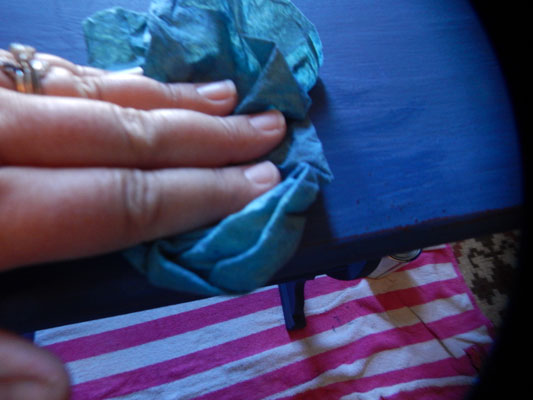
Dampen one of the shop towels and run the damp towel all over the furniture. You are trying to pick up any dust that you generated with the sandpaper.
Apply the wax.
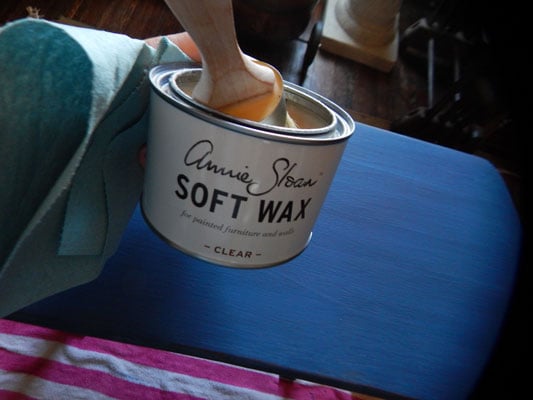
Chalk paint lacks a sealer, which most paint has, so, it requires a wax to seal the color and keep water or other debris from getting into the finish. First, make sure the paint is completely dry.
You need to use a separate brush for applying wax. Several types of brushes specific to wax application are available; they usually have a slightly rounded tip and are a bit heavier in the handle. These brushes are somewhat expensive, but the good news is that you can use the same brush multiple times to apply wax; however, once you’ve used a brush for wax, you cannot use it for painting.
Purchase your wax when you purchase your paint. For this piece, clear wax is being used.
Apply the wax generously in small sections at a time. Use the shop towels to wipe off the excess wax as you go. For this piece, for example, wax one of the outer legs and wipe off the excess wax, wax the other outer leg and wipe off the excess wax, wax the inner legs one at a time and wipe off the excess, and so on.
Note that for outdoor pieces, you do not apply wax; the piece will age and fade more rapidly, but the wax will not set outdoors.
(Optional) Apply dark wax.
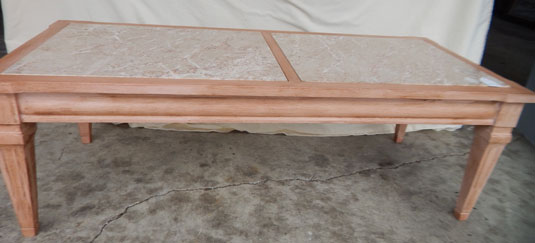
Note that you have a choice between regular wax and dark wax. The dark wax, as you probably have figured out, darkens the color and really does make a piece seem more aged. If you choose to use dark wax, note that you will need a separate brush; after you use a brush with the dark wax, you cannot reuse the brush with the regular wax or with any paint.
The coffee table shown was painted in La Chaux Candied Yam (two coats), waxed with clear wax, and then waxed with the dark wax.
Let dry and enjoy your new, old furniture.
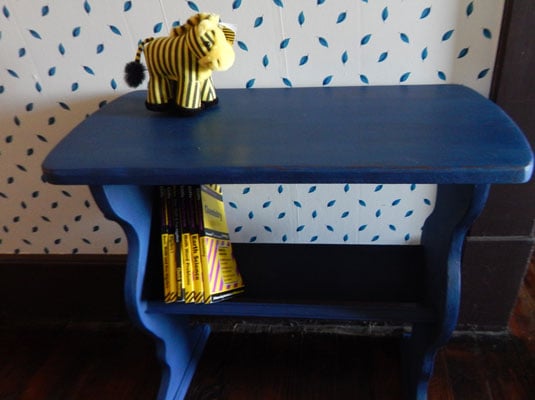
For furniture that will be heavily used (such as coffee tables), the setting time for the wax is two to three weeks. If you get overeager, though, and you find a water ring on your chalk-painted item, you can clean it with soapy water and easily repaint or buff it out with some more wax.
(Optional) Create a more modern finish with chalk paint.
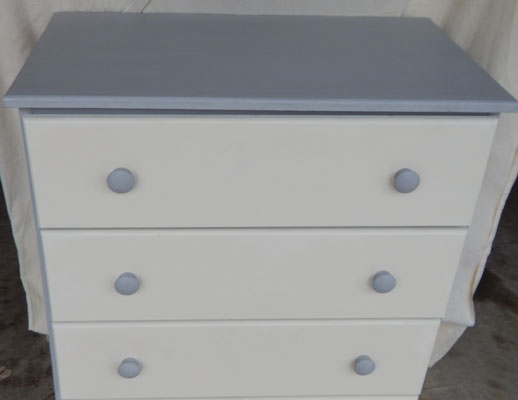
If you aren’t going to distress the piece or let it show its age by having some of the old colors show through, you will want to give the piece at least two complete coats with lots of drying time in between. This is a more modern look for painted furniture. Make sure that you are generous when applying the wax to give the piece a nice sheen.
The dresser shown was painted with Annie Sloan Paris Grey and Old White, given three coats of color, and waxed.
(Optional) Create a two-toned distressed look with chalk paint.
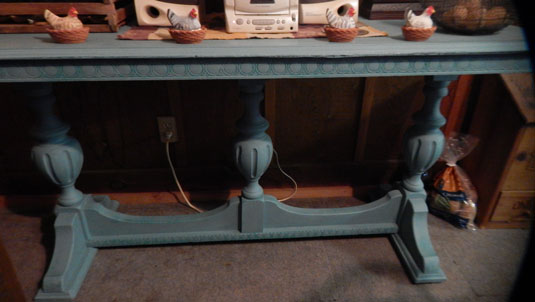
If you want a piece to have two colors (one showing through the other), make sure that the first coat is completely dry before painting the second coat of the (usually lighter) top coat. This technique is commonly used for that shabby chic look.
The table shown was originally a dark brown wood with lots of stains. It was painted with Annie Sloan Florence and Provence, given two coats of the darker Florence, given one coat of the lighter Provence, sanded, and waxed.

